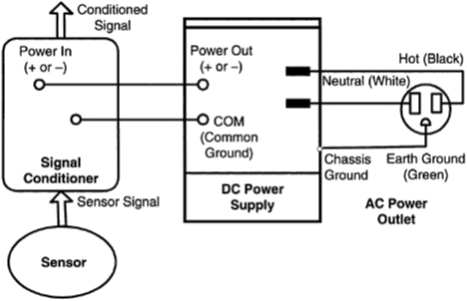SKEDSOFT
Introduction:
The shorter flat prong is connected to a black wire (hot) and the longer flat prong is connected to a white wire (neutral).
The round prong is connected to a green wire (ground), which at the other end is connected to the chassis (or, casing) of the instrument (chassis ground). In view of grounding the chassis in this manner, the instrument housing is maintained at zero potential even in the presence of a fault in the power circuit (e.g., a leakage or a short).
The power circuitry of an instrument also has a local ground (signal ground), with reference to which its power signal is measured.
This is a sufficiently thick conductor within the instrument and it provides a common and uniform reference of 0 V. Consider the sensor signal conditioning The dc power supply can provide both positive ( ) and negative (-) outputs.
Its zero voltage reference is denoted by COM, and it is the common ground (signal ground) of the device.
It should be noted that COM of the dc power supply is not connected to the chassis ground, the latter being connected to the earth ground through the round prong of the power plug of the power supply.
This is necessary to avoid the danger of an electric shock. Note that COM of the power supply is connected An example of grounding of instruments.

In this manner a common 0 V reference is provided for the dc voltage that is supplied to the signal conditioning module.
A main cause of electrical noise is the ground loops, which are created due to improper grounding of instruments.
If two interconnected instruments are grounded at two separate locations that are far apart (multiple
grounding), ground loop noise can enter the signal leads because of the possible potential difference between the two ground points.
The reason is that ground itself is not generally uniform-potential medium, and nonzero (and finite) impedance may exist from point to point within this medium. This is, in fact, the case with a typical ground medium such as a common ground wire.
In this example, the two leads of a sensor are directly connected to a signal-conditioning device such as an amplifier, one of its input leads ( ) being grounded (at point B).
The 0 V reference lead of the sensor is grounded through its housing to the earth ground (at point A).
Because of nonuniform ground potentials, the two ground points A and B are subjected to a potential difference ug. T
his will create a ground loop with the common reference lead, which interconnects the two devices.